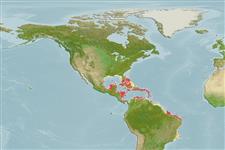Environment: milieu / climate zone / depth range / distribution range
Ecologia
marinhas associadas(os) a recifes. Tropical
Western Atlantic: southern Florida, USA and Bahamas to Espírito Santo, Brazil (Ref. 57756).
Length at first maturity / Tamanho / Peso / Idade
Maturity: Lm 1.4, range 1 - 1.5 cm
Max length : 2.5 cm TL macho/indeterminado; (Ref. 7251); Idade máx. registada: 1.00 anos (Ref. 51567)
Spend the entire cycle in beds of turtle grass, Thalassia (Ref. 51567) usually attached to the underside of the blades of the seagrass (Ref. 7251). Feed on small crustaceans: Isopoda, Amphipoda, Harpacticoida, and Ostracoda (Ref. 5521). Multiple spawner (Ref. 51567).
Distinct pairing during copulation (Ref. 205). The pair swims side to side either head to head or head to tail. Their bodies flex as they swim making their caudal areas stroke each other. The male then makes slow undulating side to side movement interrupted by short, quick twitches signalling deposition of the eggs. Fertilization probably occurred between the time of release of eggs and the depositions. Deposition of an entire clutch of eggs takes from about 20 30 minutes in 3 minute intervals (Ref. 51567).
Robins, C.R. and G.C. Ray, 1986. A field guide to Atlantic coast fishes of North America. Houghton Mifflin Company, Boston, U.S.A. 354 p. (Ref. 7251)
Categoria na Lista Vermelha da IUCN (Ref. 130435: Version 2024-1)
Ameaça para o homem
Harmless
Utilização humana
Ferramentas
Relatórios especiais
Descarregue XML
Fontes da internet
Estimates based on models
Preferred temperature (Ref.
123201): 26.4 - 28.2, mean 27.5 °C (based on 570 cells).
Phylogenetic diversity index (Ref.
82804): PD
50 = 0.7500 [Uniqueness, from 0.5 = low to 2.0 = high].
Bayesian length-weight: a=0.00617 (0.00250 - 0.01521), b=3.15 (2.94 - 3.36), in cm total length, based on LWR estimates for this (Sub)family-body shape (Ref.
93245).
Nível Trófico (Ref.
69278): 3.3 ±0.46 se; based on food items.
Generation time: 0.5 ( na - na) years. Estimated as median ln(3)/K based on 1
growth studies.
Resiliência (Ref.
120179): Elevada, tempo mínimo de duplicação da população menor que 15 meses (K=2.42; tmax=1; assuming tm<1;).
Fishing Vulnerability (Ref.
59153): Low vulnerability (10 of 100).
Nutrients (Ref.
124155): Calcium = 391 [177, 1,089] mg/100g; Iron = 1.68 [0.74, 3.44] mg/100g; Protein = 17.3 [15.8, 18.8] %; Omega3 = 0.147 [0.059, 0.398] g/100g; Selenium = 40.6 [12.4, 124.3] μg/100g; VitaminA = 126 [27, 550] μg/100g; Zinc = 4.15 [2.27, 6.82] mg/100g (wet weight);
